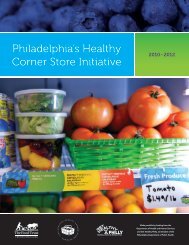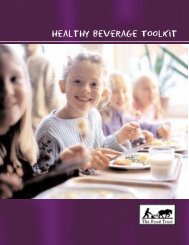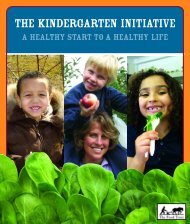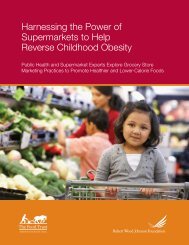The Grocery Gap: Who Has Access to Healthy - The Food Trust
The Grocery Gap: Who Has Access to Healthy - The Food Trust
The Grocery Gap: Who Has Access to Healthy - The Food Trust
Create successful ePaper yourself
Turn your PDF publications into a flip-book with our unique Google optimized e-Paper software.
PolicyLink<strong>The</strong> <strong>Food</strong> <strong>Trust</strong>Gittelsohn, J., Franceschini, M., Rasooly, I., Ries, A.,Ho, L., Pavlovich, W., San<strong>to</strong>s, V., Jennings, S., andFrick, K. “Understanding the <strong>Food</strong> Environmentin a Low-Income Urban Setting: Implications for<strong>Food</strong> S<strong>to</strong>re Interventions.” Journal of Hunger &Environmental Nutrition 2, no.2 (2008): 33-50.Glanz, K., Sallis, J., Saelens, B., and Frank,L. “Nutrition Environment Measures Surveyin S<strong>to</strong>res (NEMS-S) Development andEvaluation.” American Journal of PreventiveMedicine 32, no.4 (2007): 282-289.Helling, A., and Sawicki, D. “Race and Residential<strong>Access</strong>ibility <strong>to</strong> Shopping and Services.” HousingPolicy Debate 14, no.1 (2003): 69-101.Horowitz, C., Colson, K., Hebert, P., andLancaster K. “Barriers <strong>to</strong> Buying <strong>Healthy</strong><strong>Food</strong>s for People with Diabetes: Evidence ofEnvironmental Disparities.” American Journalof Public Health 94 (2004): 1549–1554.Hosler, A., Rajulu, D., Fredrick, B., and Ronsani,A. “Assessing Retail Fruit and VegetableAvailability in Urban and Rural UnderservedCommunities.” Preventing Chronic Disease5, no.4 (2008): 1-9. Available at http://www.cdc.gov/pcd/issues/2008/oct/07_0169.htm.Hosler, A., Varadarajulu, D., Ronsani, A., Fredrick,B., and Fisher, B. “Low-Fat Milk and High-FiberBread Availability in <strong>Food</strong> S<strong>to</strong>res in Urban andRural Communities.” Journal of Public HealthManagement Practice 12 (2006): 556–562.Inagami, S., Cohen, D., Finch K. B., and Asch, S.“You are Where You Shop: <strong>Grocery</strong> S<strong>to</strong>re Locations,Weight, and Neighborhoods.” American Journalof Preventive Medicine 31, no.1 (2006): 10-17.Jago, R., Baranowski, T., Baranowski, J.,Cullen, K., and Thompson, D. “Distance <strong>to</strong><strong>Food</strong> S<strong>to</strong>res and Adolescent Male Fruit andVegetable Consumption: Mediation Effects.”International Journal of Behavioral Nutritionand Physical Activity 4 (2007): 4-35. Availableat http://www.ijbnpa.org/content/4/1/35.Jetter, K., and Cassady, D. “<strong>The</strong> Availability andCost of Healthier <strong>Food</strong> Alternatives.” AmericanJournal of Preventive Medicine 30 (2006): 38–44.Kaufman, P. “Rural Poor Have Less <strong>Access</strong><strong>to</strong> Supermarkets, Large <strong>Grocery</strong> S<strong>to</strong>res.”Rural Development Perspectives 13 (1998):19–26. Available at http://www.ers.usda.gov/publications/rdp/rdp1098/rdp1098c.pdf.Laraia, B., Siega-Riz, A., Kaufman, J. and Jones, S.“Proximity of Supermarkets Is Positively Associatedwith Diet Quality Index for Pregnancy.” AmericanJournal of Preventive Medicine 39 (2004): 869–875.Larson, N., S<strong>to</strong>ry, M., and Nelson, M.“Neighborhood Environments Disparities in <strong>Access</strong><strong>to</strong> <strong>Healthy</strong> <strong>Food</strong>s in the U.S.” American Journal ofPreventative Medicine 36, no.1 (2009): 74-81.Lavin, M. “Supermarket <strong>Access</strong> and ConsumerWell-Being: <strong>The</strong> Case of Pathmark in Harlem.”International Journal of Retail and DistributionManagement 33, no.5 (2005): 388-398.Liese, A., Weis, K., Plu<strong>to</strong>, D., Smith, E., and Lawson,A. “<strong>Food</strong> S<strong>to</strong>re Types, Availability, and Cost of <strong>Food</strong>sin a Rural Environment.” Journal of the AmericanDietetic Association 107 (2007): 1916–1923.Liu, G., Wilson, J., Qi, R., and Ying, J. “GreenNeighborhoods, <strong>Food</strong> Retail and ChildhoodOverweight: Differences by PopulationDensity.” American Journal of HealthPromotion 21, no.4 (2007): 317-325.Moore, L., and Roux, A. “Associations ofNeighborhood Characteristics with the Locationand Type of <strong>Food</strong> S<strong>to</strong>res.” American Journalof Public Health 96 (2006): 325–331.Moore, L., Roux, A., and Brines, S. “ComparingPerception-Based and Geographic InformationSystem (GIS)-Based Characterizations ofthe Local <strong>Food</strong> Environment.” Journal ofUrban Health: Bulletin of the New YorkAcademy of Medicine 85, no.2 (2008).Moore, L., Roux, A., Nettle<strong>to</strong>n, J., andJacobs, D. “Associations of the Local <strong>Food</strong>Environment with Diet Quality—A Comparison ofAssessments Based on Surveys and GeographicInformation Systems: <strong>The</strong> Multi-Ethnic Studyof Atherosclerosis.” American Journal ofEpidemiology 167 (2008): 917–924.Morland, K., and Filomena, S. “Disparities in theAvailability of Fruits and Vegetables BetweenRacially Segregated Urban Neighbourhoods.” PublicHealth Nutrition 10, no.12 (2007): 1481-1489.Morland, K., Roux, A., and Wing, S. “Supermarkets,Other <strong>Food</strong> S<strong>to</strong>res, and Obesity: <strong>The</strong> Atherosclerosis26






